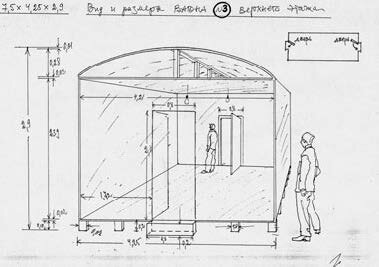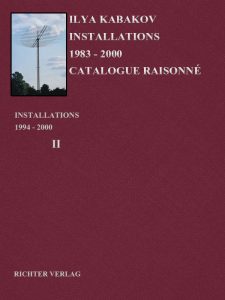We Are Living Here
YEAR: 1995
CATALOG NUMBER: 86
PROVENANCE
Not preserved as installation
Collection of the artist
NOTES
See CRI, vol 2, No 90 and CRI, vol 3, No 168
EXHIBITIONS
Paris, Centre national d’Art et de culture Georges Pompidou
Ilya Kabakov. C’est ici que nous vivons, 16 May 1995 — 4 Sep 1995
Hamburg, Deichtorhallen
Ilya Kabakov. Der Lesesaal – Bilder, Leporellos und Zeichnungen, 19 Apr 1996 — 28 Jul 1996 (only Beautiful Girls as part of No 90, The Reading Room)
Schirn Kunsthalle Frankfurt, Frankfurt am Main, Germany
Traumfabrik Kommunismus: Die Visuelle Kultur der Stalinzeit / Dream Factory Communism: The Visual Culture of the Stalin Era, September 24, 2003 to January 4, 2004.
Van Abbemuseum, Eindhoven, Netherlands
Lissitzky – Kabakov: Utopie en Werkelijkheid / Lissitzky – Kabakov: Utopia and Reality, December 1, 2012, to April 1, 2013 (elements of the installation slightly modified).
DESCRIPTION
The installation represents a large construction area where the construction of a grandiose structure has already begun – perhaps it is a ‘Beautiful Palace of the Future’ – 5 white columns have already been erected inside a net of metal scaffolds. Construction material lies all around on the ground: boards, wires, sand, etc. In the middle, in the center of the structure, there is a stand, as at any construction site, depicting what is to be erected here – ‘Beautiful Palace’ and the city around it. Along the perimeter of the entire site stand the trailers of the construction workers. These trailers are of varying size – tall, long, narrow, and wide. The viewer of the installation enters inside this perimeter and passes from one dwelling to another. In doing so, the viewer discovers inside an enormous, diverse world – here are dormitories, and libraries, and cafeterias, and daycare centers, and the project division, and a meeting room and many other spaces: cloakrooms, kitchens, ‘game rooms,’ one- and two-room apartments, etc. All of this has the appearance that it has been ‘built’ up and lived in for a long time.
But scrutinizing the ‘structure’ closely, the viewer discovers that it has been stopped long ago, has been abandoned, and all of it together – the scaffolding and the material that has been brought here – represent a long forgotten heap of garbage. But the lives of the people inside these temporary little construction buildings, on the contrary, are all going on in their own ordinary way, have turned into banal ordinariness in all of its various forms.
What was supposed to become the beautiful shining ‘tomorrow’ has stopped, has become the eternal immobile ‘now,’ and it is not at all clear what can be done with it. And what was intended to be temporary, for service purposes – the trailers for the workers, with their congestion, not equipped as residences – has turned out to be permanent places of inhabitance for people, for a few generations, in fact.
The installation has two-stories. Descending down, under the floor along the stairs, the viewer again sees, this time, amidst the columns of the lower floor, other rooms of the ‘city of builders’: a movie theater, a clinic, and again small apartments with their own lives.
Of course, it is clear what metaphor this installation represents: a unique monument to the utopia of the 20th Century, the ‘building of communism in a single country.’ But isn’t there also in this installation something that relates not only to what happened in Russia and in its history?
The installation should be built on the first and basement floors of the George Pompidou Center.
Images
Literature












